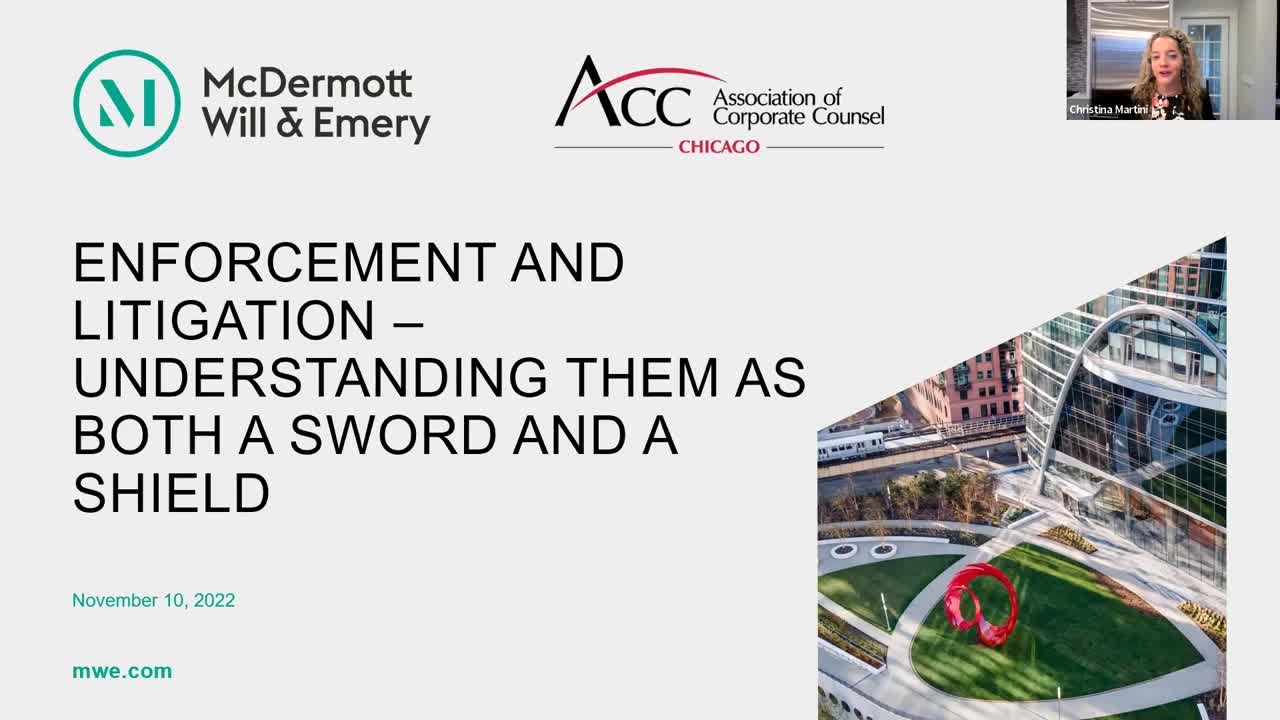Overview

As consumer-facing product and service companies go head-to-head in an increasingly competitive marketplace, the risks of doing business are higher than ever before. Whether marketing your products to generate the highest return, navigating an increasingly aggressive enforcement environment or confronting complex litigation, it’s critical to avoid the abundant consumer protection roadblocks when charting the path to your business’s success.
This second webinar of the two-part virtual program “Consumer Protection: Establishing and Protecting Your Competitive Position”—co-presented by McDermott Will & Emery and the Association of Corporate Counsel Chicago (ACC Chicago)—addressed strategies and best practices for responding to different government investigations, defending against consumer protection class actions and utilizing litigation claims against competitors.
Below are key takeaways from the session.
FEDERAL TRADE COMMISSION (FTC) AND STATE ENFORCEMENT TRENDS
- The Supreme Court of the United States overturned a $1.25 billion summary judgment award and ruled 9-0 that the FTC could not obtain redress or disgorgement under Section 13(b) of the FTC Act in AMG Capital Management v. FTC.
- Section 13(b) was the provision the FTC historically relied on for money in consumer protection matters.
- The FTC turned to other provisions and methods, including their penalty offense authority, which in certain circumstances allows the FTC to obtain monetary redress when a company knows that its practices are unfair or deceptive and the FTC had issues opinions on the subject.
- To establish that knowledge requirement, in October 2021 the FTC launched a preemptive letter-writing campaign in which it sent out nearly 2,000 letters to for-profit higher education institutions and other businesses warning them against taking specific actions (e.g., making false promises about job prospects, posting fake reviews or using misleading endorsements) and putting them on notice about potential penalties.
- The FTC and state agencies are also showing greater interest in the following:
- Fake consumer reviews (a.k.a. “testi-phony-als”)
- Relationships between so-called influencers and brands
- Other deceptive endorsements
- The FTC is also cracking down on the following:
- Consumer surveillance practices
- Advertising on the metaverse
- Use of digital “dark patterns” to manipulate individuals into providing personal information or buying products
- Other agencies, including the Securities Exchange Commission (SEC) are jumping into the fray, highlighted by the SEC’s recent $1.3 million settlement with Kim Kardashian over inadequate disclosures.
Key consideration: The FTC is engaging in a flurry of new rulemaking and developing new guidance documents to help strengthen its efforts to ensure compliance.
CONTRIBUTORY FALSE ADVERTISING
- The Lanham Act is being used by some courts to hold manufacturers “contributorily liable” for false advertising, in addition to trademark infringement. Further, the US Congress does not appear to have intended for the Lanham Act to be limited in a manner that prevents a contributory infringement claim for false advertising.
- Direct false advertising requires a plaintiff to prove that the defendant made false or misleading statements of fact in a commercial advertisement or promotion that deceives or is likely to deceive consumers in a material way, is disseminated in or affects interstate commerce, and is likely to harm the plaintiff.
- A contributory false advertising claim requires that the plaintiff demonstrate that a third party directly engaged in false advertising that caused injury to the plaintiff or contributed to that conduct by either knowing inducing or causing the conduct or materially participating in it.
Key consideration: Forum selection is important; since the courts are not unanimous in applying this doctrine, filing or defending a complaint in a venue that supports your client’s position is essential. As appropriate, focus on proving or disproving whether defendant acted knowingly or intentionally.
EMERGING CLASS ACTION TRENDS
- COVID-19-related class actions (many involving refunds, insurance and Paycheck Protection Program (PPP) False Claims Act (FCA) violations) are still working their way through the courts.
- The Illinois Supreme Court opened the Biometric Information Privacy Act (BIPA) floodgates in its 2019 Rosenbach decision.
Key consideration: BIPA penalties and settlements can be incredibly steep. The first-ever BIPA trial resulted in a $228 million judgment and typical settlements are starting at $700 per class member.
STRATEGIES FOR GOVERNMENT INVESTIGATIONS
- To prevent or minimize potential investigations, establish compliance programs and training, and document practical policies and guidelines (e.g., lists of words that can and cannot be used).
- During an investigation, get ahead of the agency: conduct an internal investigation (using outside counsel to preserve privilege), be proactive and prepared for surprises, don’t dismiss the idea of settlement, and understand the role of third parties (who may or may not be allies).
- After an investigation, get ready for possible negative PR and identify lessons learned.
Key consideration: You must take FTC investigations seriously. They can be lengthy, require targets to be forthcoming and may be shared with other agencies. Avoid common mistakes, such as failure to preserve documents and misunderstanding the role of attorney-client privilege.
MONEY DAMAGES AND OTHER REMEDIES
- Courts have significant discretion in Lanham Act cases; damages claims are subject to principals of equity (and cannot represent a “windfall” to the plaintiff).
- “Willfulness” is critical. Damages can include the plaintiff’s lost profits and the defendant’s profits, but the latter are included only if willfulness or actual injury are proven by the plaintiff. Injunctive relief, however, does not required willfulness or actual injury.
- Corrective advertising is a powerful, but expensive, remedy.
Key consideration: Forum selection is again important here (as courts do not all have the same perspective on awards of disgorgement of profits), as is proof of causation (particularly in multi-seller markets). It may be worthwhile to consider other measures of damages, such as surveys of favorable purchaser views from false advertising, or extrapolation of future lost sales from the period of harm to date.
Want to learn more about establishing and protecting your competitive position? Check out the key takeaways from Part 1 of the webinar.